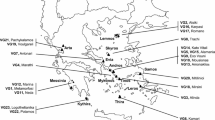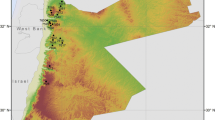Abstract
Geographic variation in protein content of wild barley,Hordeum spontaneum, and the associations of protein content with ecological and allozyme markers were tested in an attempt to derive predictive guidelines for conservation and utilization in breeding programs. The study involved 195 genotypes of wild barley from 25 populations, 15 central and 10 marginal. These populations had been tested earlier for allozymic variation (Nevo & al. 1979 a, b). The results indicate that protein content varies both within, but particularly between populations. Notably, the 10 marginal populations exhibit high protein content but low kernel weight, as compared with the 15 central populations which displayed lower protein content but high kernel weight. Three variable combinations of climatic factors explain 40% of the variability in protein content among populations. Likewise, 3 variable combinations of allozyme allele frequencies explain a significant degree of spatial variance in protein content (R square = 0.63). — We conclude that natural populations of wild barley in Israel contain large amounts of yet untapped genes for protein content. These could be effectively screened and utilized for producing high protein cultivars of barley by following ecological and allozymic markers as predictive guidelines in screening natural populations of wild barley.
Similar content being viewed by others
References
Ahokas, H., 1977: Lysine and tryptophan content of some high-protein stocks and species ofHordeum. — Hereditas86, 143–145.
, 1982: Variation of kernel protein and lysine in the wild progenitor of barley. — Hereditas96, 29–37.
Atlas of Israel, 1970: Survey of Israel. — Jerusalem: Ministry of Labour. — Amsterdam: Elsevier Publ. Co.
Brown, A. H. D., Nevo, E., Zohary, D., 1978: Outcrossing rates and heterozygosity in natural populations ofHordeum spontaneum Koch in Israel. — Heredity41, 49–62.
,Munday, J., 1982: Population genetic structure of land races of barley from Iran. — Genetica58, 85–96.
Falconer, D. S., 1960: Introduction to Quantitative Genetics. — London: Oliver and Boyd.
Feldman, M., Sears, E. R., 1981: The wild gene resources of wheat. — Sci. Amer.244, 102–112.
Frankel, O. H., Bennett, E., 1970: Genetic Resources in Plants—Their Exploration and Conservation. — Oxford: Blackwell.
,Soule', M. E., 1980: Conservation and Evolution. — Cambridge: Univ. Press.
Grama, A., Gerechter-Amitai, Z. K., Blum, A., 1984: Wild emmer as donor of genes for resistance to stripe rust and for high protein content. — Proc. 6th IWGS Kyoto Japan1983, 187–192.
Harlan, J. R., 1976: Genetic resources in wild relatives of crops. — Crop Sci.16, 329–333.
Johnson, V. A., Mattern, P. J., Vogesl, K. P., 1973: Cultural, genetic and other factors affecting quality of wheat. — InSpicer, A., (Ed.): Bread: Social, Nutritional and Agricultural aspects of Wheat Bread, pp. 127–140. — London: Applied Science Publishers Ltd.
- -Schmidt, J. W., Stroike, J. E., 1975: Genetic advances in wheat protein quality and compositions. — Proc. 4th Int. Wheat Genetics Symp. Columbia, Missouri, pp. 547–556.
Ladizinsky, G., 1975: Collection of wild cereals in the Upper Jordan Valley. — Econ. Bot.29, 264–267.
Moseman, J. G., El-Morshidy, M. A., Wahl, I., Nevo, E., Tomerlin, J. R., Zohary, D., 1983a:Hordeum spontaneum resistant to leaf rust, powdery mildew, scald and net blotch. — Agronomy Abstracts (Washington D.C.), p. 74.
,Nevo, E., Zohary, D., 1983b: Resistance ofHordeum spontaneum collected in Israel to infection withErysiphe graminis hordei. — Crop. Sci.23, 1115–1119.
- -El-Morshidy, M. A., Zohary, D., 1985: Reactions ofHordeum spontaneum to infection with Israeli and United States cultures ofPuccinia hordei. — Euphytica (in press).
Nevo, E., 1983: Genetic resources of wild emmer wheat: structure, evolution and application in breeding. — Proc. 6th IWGS Kyoto Japan1983, 421–431.
,Zohary, D., Brown, A. H. D., Haber, M., 1979a: Genetic diversity and environmental associations of wild barley,Hordeum spontaneum in Israel. — Evolution33, 815–833.
,Brown, A. H. D., Zohary, D., 1979b: Genetic diversity in the wild progenitor of barley in Israel. — Experientia35, 1027–1029.
,Moseman, J. G., Beiles, A., Zohary, D., 1984a: Correlation of ecological factors and allozymic variations with resistance toErysiphe graminis hordei inHordeum spontaneum in Israel: patterns and applications. — Pl. Syst. Evol.145, 79–96.
,Beiles, A., Gutterman, Y., Storch, N., Kaplan, D., 1984b: Genetic resources of wild cereals in Israel: II. Phenotypic variation within and between populations of wild barley,Hordeum spontaneum. — Euphytica33, 717–735.
,, , , , 1984c: Genetic resources of wild cereals in Israel: I. Phenotypic variation within and between populations of wild wheat,T. dicoccoides. — Euphytica33, 737–756.
- -Kaplan, D., Storch, N., Zohary, D., 1985a: Genetic diversity and environmental associations of wild barley,Hordeum spontaneum, in Iran. — (Submitted.)
- -Storch, N., Kaplan, D., Zohary, D., 1985b: Genetic diversity and environmental associations of wild barley,Hordeum spontaneum, in Turkey. — (Submitted.)
- -Zohary, D., 1985c: Genetic structure and evolution of wild barley,Hordeum spontaneum, in the Fertile Crescent. — (Submitted.)
-Grama, A., Beiles, A., Golenberg, E. M., 1985d: Resources of high-protein genotypes in wild wheat,Triticum dicoccoides in Israel: Predictive method by ecology and allozyme markers. — Genetica (in press).
-Moseman, J. G., Beiles, A., Zohary, D., 1985e: Patterns of resistance of wild wheat to pathogens in Israel: I. Predictive method by ecology and allozyme genotypes, for powdery mildew and leaf rust. — (Submitted.)
-Gerechter-Amitai, Z. K., Beiles, A., Golenberg, E. M., 1984f: Patterns of disease resistance of wild wheat in Israel: II. Predictive method by ecology and allozyme genotypes for stripe rust. — (Submitted.)
Plucknett, D. L., Smith, N. J. S., Williams, J. T., Anishetty, N. M., 1983: Crop germplasm conservation and developing countries. — Science220, 163–169.
Pomeranz, Y., Robbins, G. S., Smith, R. T., Craddock, J. C., Gilbertson, J. T., Moseman, J. G., 1976: Protein content and amino acid composition of barleys from the World Collection. — Cereal Chem.53, 497–504.
SPSS-x 1983. User's guide. — New York: McGraw-Hill Co.
Tanksley, D., Medina-Filho, H., Rick, C. M., 1982: Use of naturally-occurring enzyme variation to detect and map genes controlling quantitative traits in an interspecific backcross of tomato. — Heredity49, 11–25.
Thompson, J. N., Jr., Thoday, J. M., 1979: Quantitative Genetic Variation. — New York: Academic Press.
Author information
Authors and Affiliations
Rights and permissions
About this article
Cite this article
Nevo, E., Atsmon, D. & Beiles, A. Protein resources in wild barley,Hordeum spontaneum, in Israel: Predictive method by ecology and allozyme markers. Pl Syst Evol 150, 205–222 (1985). https://doi.org/10.1007/BF00984197
Received:
Issue Date:
DOI: https://doi.org/10.1007/BF00984197




